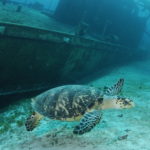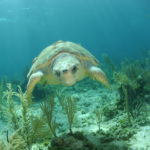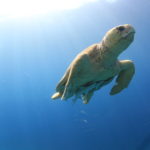It's common to see turtles on dives, but many divers don't know about the threats facing sea turtle populations around the world.
Threats facing sea turtle populations globally
Sea turtles are high on the list of marine animals we want to see while diving. Although the status of marine-turtle populations varies from country to country, they are generally considered to be declining globally despite successful local conservation efforts in many countries.



Sea turtles face threats both in the water and on land. The top five threats to turtles as identified by the IUCN are:
- Fisheries impacts: Sea turtles die every year from accidental entanglement in active and derelict fishing nets. We deprive them of habitat by trawling and they lose their food source because of disruptions in the food web.
- Direct take: Human beings kill sea turtles for food and shells. Their eggs are poached by human and animal predators.
- Coastal development: Beach degradation, seafloor dredging, vessel traffic, and loss of natural vegetation all destroy and disturb sea-turtle nesting habitats. Brightly lit beachfront homes disrupt nesting behavior and hatchling orientation contributing to hatchling deaths.
- Pollution and disease: Sea turtles ingest and become entangled in plastics, discarded fishing gear, and petroleum byproducts. Chemical pollutants weaken sea turtles' immune systems, making them susceptible to disease.
- Global warming: The natural, temperature determined, sex ratios of hatchlings are becoming skewed by global-temperature increases. A predicted increase in extreme weather events will result in loss of nesting beaches and other critical sea turtle habitats.
What you can do to help
- Do not purchase souvenirs made from turtle products, corals or any threatened or endangered species. CITES and many national laws protect turtles.
- While traveling, choose resorts and tour operators that properly treat all sewage and wastewater and dispose of trash correctly.
- Stop eating seafood. If you must, choose animals caught or harvested from verifiably sustainable fish populations. And never eat animals that have been farmed or caught using destructive or unsustainable practices, including poisons, explosives or illegal equipment.
- Participate in regular cleanup efforts and remove debris you find during a dive that could entangle or choke a sea turtle.
- Report any activity you deem harmful to sea turtle populations to the appropriate authorities.
- Be aware of your actions when viewing nesting or hatching sea turtles.
- Assist scientific research and improve resource management by reporting your sightings to conservation organizations. Support international, national and regional legislation that advocates for increased sea-turtle protection.
How to dive responsibly with turtles
- Do not touch, handle, feed, harass or ride a turtle. These actions stress the animal, interrupt natural feeding and mating behavior and may provoke aggressive behavior in non-aggressive species.
- Give the turtle space to move away. Do not restrict its normal movement or direction of travel. You can drown the turtles if you prevent them from reaching the surface to breathe.
- Know local regulations and protocols regarding your behavior around turtles before entering the water. These are designed to ensure the animal's well-being.
- When taking photos, maintain distance between you and the turtle, and don't interfere with its natural behavior and environment. Passive observation means that you take photos or videos in a way that won't frighten or otherwise disturb the turtle. Do not use flash photography or videography, as these stress the turtle and will cause it to move away.
- Watch out for turtles when boating. If a boat strikes a turtle it will likely cause injury or death.
Sea Turtle Awareness specialty course
Find a dive shop that offers the Project AWARE Sea Turtle Awareness specialty. This course is for Open Water Divers age 10 and older. The course offers knowledge development, two open-water dives and basic sea-turtle identification and conservation information. During your dives you'll identify and monitor turtles, as well as remove harmful debris.
Correctly identifying a sea turtle allows you to record sightings with conservation groups and help provide vital information about that turtle and where you saw it. You'll also learn about the decline in sea turtle populations, the importance of sea turtles to marine biodiversity, and what you can do to reduce sea-turtle threats worldwide.
The post Threats Facing Sea Turtle Populations appeared first on Scuba Diver Life.
from Scuba Diver Life https://ift.tt/2GumSVB
No comments:
Post a Comment